人教版九年级英语第七单元教案解析
- 格式:doc
- 大小:116.00 KB
- 文档页数:13

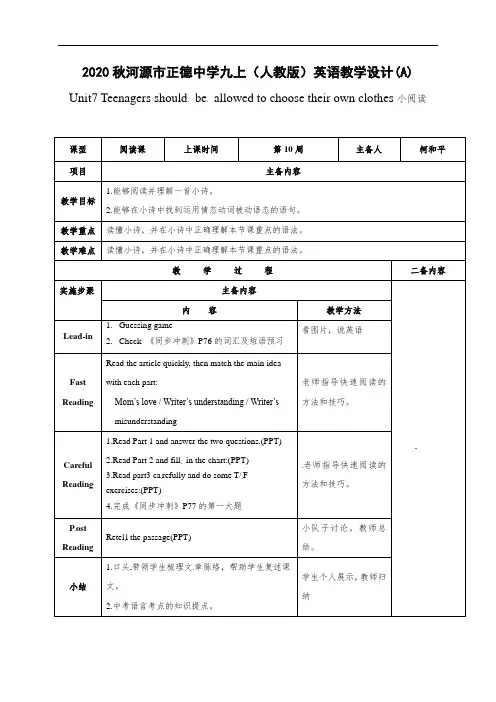

人教版九年级英语第七单元阅读Lesson: I'd love to sail across the PacificBackground information:Students: 50 Junior high school students, Grade 3Lesson deration: 40 minutesTeaching objectives:By the end of this class, students should be able to:1. understand some new words;2. express their hopes and dreams use “I’d love/like to…”;3. realize they should fight for their hopes and dreams.Teaching contents:The text: I'd love to sail across the Pacific.Words: across, thousands of, dream, willing, etc.What’s your hope/dream? I’d love/like to …Teaching aids: blackboard, chalk, PPTType of the lesson: readingTeaching procedures:Step 1. Warm up and lead in:(2 minutes)1). Warm up:Greet students.2). Lead in:listen a song.Teacher: Good morning, boys and girls. Are you ready to begin our class? No? OK, since you are not ready, let’s go to listen a song first.Do you like it? This song is about dream, also, today our theme is dream as well as hope. Now, let’s go to learn the reading-I'd love to sail across the Pacific.Step 2. Pre-reading:(5 minutes)1). review “I’d love/like to…”2). “What’s your dream/hope?”“I’d love/like to…”Teacher: Boys and girls, look at this sentence-I'd love to sail across the Pacific. Do you know the Chinese meaning? Great…Now, let’s have a quick review of it. When someone asks “where would like to visit?” we can answer “I’d love/like to…”Now, I’d like to tell you, when someone asks “what’s your dream/hope?” we can also use it to answer. Understand? Good! So, what’s your dream? …Great! And what’s your hope? … So all of you understand it.Step 3. While-reading.(25 minutes)1). Skim the text, and do a matching.2). Scan the text part by part, and do some tasks.3). Review the whole text.Teacher: Now, open your book, turn to page 58. Look at the text, it has been divided into four parts. Now, I’d like you to skim the text and do this matching. Clear? Good! I’ll give you two minutes. Go! Finish? Who wants to give me the answer? Very good! Sit down please. Part 1… Part 2… Part 3… Part 4…Is there anyone have different ideas? No. So we can go on.Now, I’d like you scan the text part by part. First, part 1. Only three sentences, you have two minutes to read it, and you should finfish these two tasks. … Time’s up. Any volunteers. Amy. You did very well. How about this? Jack, it is true or false. Nice, it is false. How do you know? Good, we can learn from this sentence:…“across”, it means “in every part of a place”. So how to say… Besides, look at this phrase “thousands of”, it means… So how to translate…Great, you are so clever! So let’s translate this sentence:… Good. Is everything clear?Good, let’s move to part 2-What are the hopes of teenagers? Three minutes, and then answer these questions. Clear? Go now! OK, do you get the answers? Good, Lucy, the first question… You are so smart! Question 2… Question 3…Now, let’s go to read part 3-What are the dreams of teenagers? Three minutes to read it and finish this table. Finish? Good, Alice… Smart girl! … OK.The last part- the conclusion. Let’s read it together. This part refers four words:…Can you put them in the right place. Good, teenagers’ hope is similar, and their dream is different. Now, look at this sentence:… Pay attention to the blue word: dream. Wehave learned it as a non. But in this place, is it a non.? No, it’s a verb. Good! Dream…Dream of… Is everything clear?Good. So let’s have a review of this text. I’ll give you one minutes to fill in the blanks. Finish? Read it together: … so do you have any questions about this text? You don’t have. But I have two.Step 4. Post-reading.(6 minutes)Pair work: Discuss two question “What are your dreams?What should we do to make our dreams come true?”Teacher: I’d like you work in pairs to discuss these questions. Three minutes, OK? Go please. Stop here, who want to share you opinions? Good, Anna. Good dreams! What’s more? Good, we should keep our dreams in our mind, and study hard. So do it! Anyone else? I know all of you have good ideas about dreams, but we have no time to share it together, so share with your friends after class, OK?Step5. Homework and goodbye. (2 minutes)No homework.Teacher: Now, I have to give you some homework. Do you want to have homework? No? OK, tell me the complete sentence, if you are right, no homework, but if you make some mistakes, more homework. Say it out together. Great, you are so clever. So, no homework today. OK, so long for today, goodbye, class, and dream a good dream!。
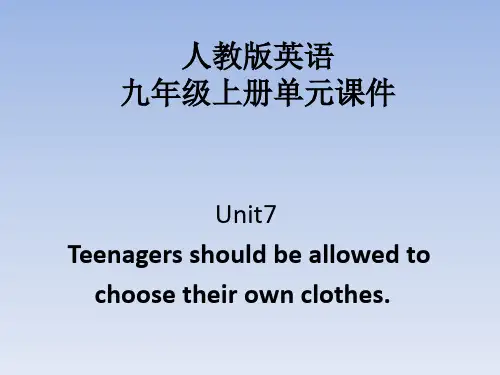
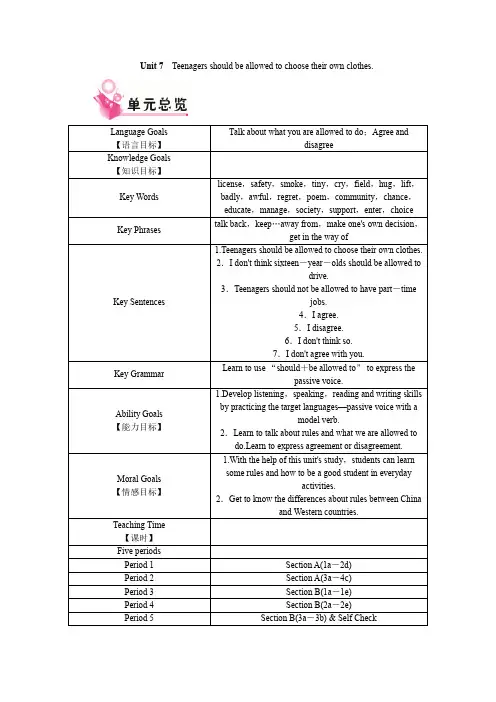
Unit 7Teenagers should be allowed to choose their own clothes.Language Goals 【语言目标】Talk about what you are allowed to do;Agree anddisagreeKnowledge Goals 【知识目标】Key Words license,safety,smoke,tiny,cry,field,hug,lift,badly,awful,regret,poem,community,chance,educate,manage,society,support,enter,choiceKey Phrases talk back,keep…away from,make one's own decision,get in the way ofKey Sentences 1.Teenagers should be allowed to choose their own clothes. 2.I don't think sixteen-year-olds should be allowed todrive.3.Teenagers should not be allowed to have part-timejobs.4.I agree.5.I disagree.6.I don't think so.7.I don't agree with you.Key Grammar Learn to use “should+be allowed to” to express thepassive voice.Ability Goals 【能力目标】1.Develop listening,speaking,reading and writing skills by practicing the target languages—passive voice with amodel verb.2.Learn to talk about rules and what we are allowed to do.Learn to express agreement or disagreement.Moral Goals 【情感目标】1.With the help of this unit's study,students can learnsome rules and how to be a good student in everydayactivities.2.Get to know the differences about rules between Chinaand Western countries.Teaching Time【课时】Five periodsPeriod 1Section A(1a-2d)Period 2Section A(3a-4c)Period 3Section B(1a-1e)Period 4Section B(2a-2e)Period 5Section B(3a-3b) & Self Check本单元围绕“规则”这个核心话题,讲述哪些事情是允许青少年做的,哪些事情是不允许做的,对学生的成长有重要意义。

Unit 7 Teenagers should be allowed to choose their own clothes.The First Period Section A 1a–2cTeaching aims(教学目标)口、笔头掌握句型1. A: I don’t think sixteen-year-olds should be allowed to drive.B: I agree. They aren’t serious enough at that age.2. A: Do you think teenagers should be allowed to choose their own clothes?B: Yes, I do. / No, I don’t.13. Sixteen-year-olds should be allowed to get their ears pierced.4. He should stop wearing that silly earring.5. Students must not be allowed to have part-time jobs.熟练掌握词汇:smoke, license, safety. 了解下列词汇:pierce, earring技能目标:能用should/should not be allowed to do谈论应该被允许和不应该被允许做的事情。
情感态度:勇于发表自己的观点和意见,表达同意或不同意。
Difficulties(难点):be (not) allowed to doTeaching steps(教学步骤)21. Warm-up and revision(课堂热身)Show pictures of “Where are dads going?”Kid: Can I drive my friends to the mall?Dad: No, you are not allowed to drive.教学设计说明: 通过情景对话复习情态动词can并且引进新知be( not) allowed to2. Presentation(呈现新知识)呈现王磊和多多的对话练习句型结构3A:Teenagers should not be allowed to smokeB: I agree.教学设计说明:操练句型结构3. Work on 1a.T: Read the statements below. Circle A for agree or D for disagree.1. Teenagers should not be allowed to smoke.2. Sixteen-year-olds should be allowed to drive.3. Students should not be allowed to have part-time jobs.4. Sixteen-year-olds should be allowed to get their ears pierced.45. Teenagers should be allowed to choose their own clothes.4. Work on 1b.T: Listen and circle T for true or F for false.•Anna can go to the shopping center by bus.•Anna wants to get her ears pierced.•Anna wants to choose her own clothes.T:Listen again and complete the conversation.• A. be allowed to choose their own clothes• B. shouldn’t be allowed to get their ears pierced5• C. should be allowed to driveAnna: Mom, can I go to the shopping center with John? He just got his driver’s license. Mom: No way! I don’t think sixteen-year-olds ___________. I’m worried about your safety. Anna: But Gaby’s getting her ears pierced at the shopping center and I want to watch. Mom: Sixteen-year-olds __________________ either. They’re too young.Anna: I agree, but it’s fun to watch. Can I take the bus then?Mom: Well, OK.Anna: Great! I want to buy a new skirt, too.Mom: What kind of skirt? Maybe I should go with you.6Anna: Aww, Mom. I’m not a child. I think teenagers ____________________.Mom: Well, I just want to make sure you get something nice.观察与思考:请观察听力原文中的填写句子。

⼈教版九年级英语第七单元知识讲解Unit 7 Teenagers should be allowed to choose their own clothes.词句精讲精练【词汇精讲】1. choosechoose作动词,意为“选择,挑选”,后接宾语,常⽤搭配如下:choose sth. for sb. 为某⼈选择某物;choose sb. to do sth. 选择某⼈做某事;choose + wh从句(where,what,when等引导的特殊疑问句)例如:We have chosen a birthday present for you. 我们已经为你选择了⼀个礼物。
I’d like to choose Jim to go there with me. 我选择吉姆和我⼀起去。
Our teacher will let us choose where we should have our picnic.我们⽼师要我们选择哪⼉野炊。
2. chance(1)chance表⽰“机会”,是可数名词,要表⽰“做某事的机会”,其后可接to do sth. 或of doing sth.。
例如:It is a good chance to study English. 这是学习英语的好机会。
I have a chance of going to Beijing. 我有机会去北京。
(2)表⽰“希望”、“可能性”,可⽤作可数名词或不可数名词。
要表⽰“做某事的可能性”,通常后接“of doing” 形式。
例如:He has a good chance of winning. 他很有希望获胜。
There is still chance that you will pass the exam.你考试及格还是有希望的。
(3)⽤于by chance, 意为“偶然地”、“⽆意中”。
例如:He met her by chance. 他是偶然遇到她的3. manage(1) 作动词,意为“管理;经营;处理”。

九年级—unit7.where would you like to visit?说课稿一教材分析1、教材的地位和作用本单元的中心话题是Vacations,整个单元的内容是围绕Vacations的对话,以及个人的自我介绍展开的。
通过本单元的学习,要求学生能够谈论自己想去的地方,并学会介绍旅游景点,同时了解世界各地的一些名胜古迹,从而能自觉地保护地球,保护环境。
因此,国家和旅游景点的介绍,不仅在本单元占据主导地位,也是训练学生口语表达能力的良好素材。
根据新目标对学生交际能力的培养,尤其对学生口语及阅读能力的要求不断提高,我将本课设计为一堂口语会话课。
2、教学目标为了完成正常的教学任务,还要有效地培养学生的创新精神和实践能力,结合学生实际和教学内容,我确立如下的教学目标:知识目标:A:掌握表达出游意愿的句型:would like to 和 hope to。
B:掌握本单元的重点词汇,包括景点、国家等。
能力目标:A:学会谈论自己想去的地方,学会介绍旅游景点。
B:会使用单元中的基本句型及其回答。
C:能从听到的对话中获取信息,提高听力技能。
情感目标:A:通过对本单元的学习,增强实际交际能力。
B:通过本单元的学习使学生加深对世界各地的了解,自觉形成保护地球,保护环境的意识。
3、重点和难点重点:根据新目标对口语会话能力的要求,我确定本课重点为:A:掌握有关国家和地点的词汇和相关的词组B:能够运用所学句型,比较流利地描述一个自己想去的地方。
难点:根据实际情况,我认为本单元的难点有两方面:A:从地图中熟练地找出学过的国家和城市所在的地理位置。
B:口语水平的提高。
二、说教法根据课文内容,结合创新教育理论,在课堂教学中采用讲、练相结合的方法。
另外,充分利用各种图片创设情境,使学生自然融于对话的意境中去,从而将英语学习与美术、地理、旅游活动相结合,以深化对知识的感悟、对英语听、说、读、写等全方面的培养。
三、说学法本单元是口语会话课,中国有句古话“受人以鱼,不如授人以渔”,因此本课中主要采用讨论法和角色扮演的学习策略,让学生在活动中自主地学习新词汇、重点句型,提高解决问题的能力及综合运用语言能力。
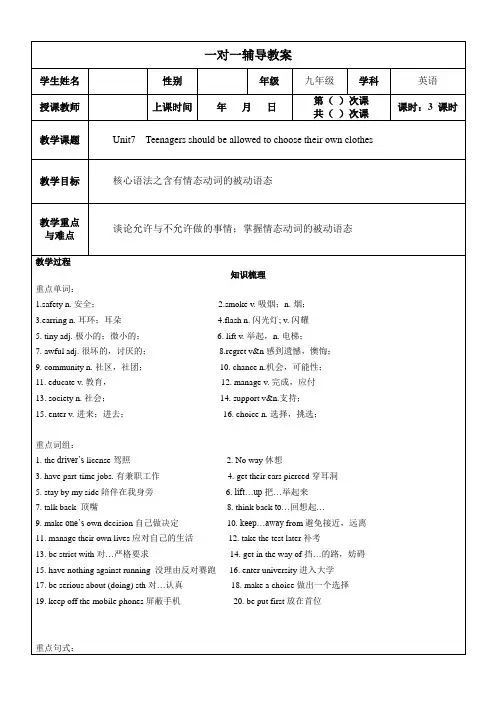

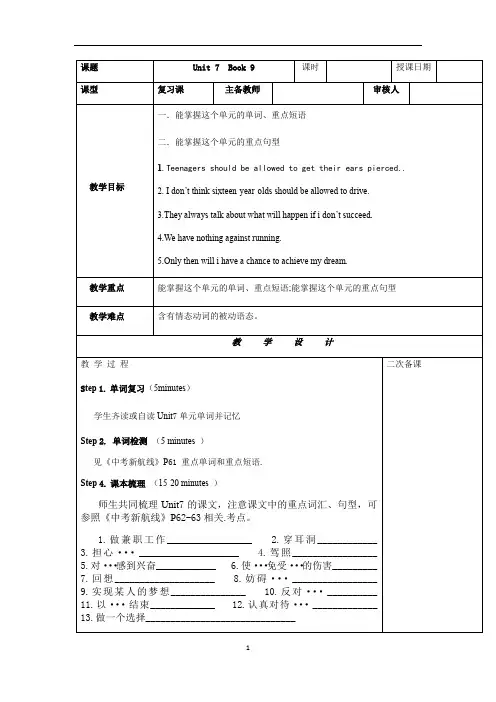
考点讲练强化:1.Sixteen-year-olds shouldn’t be allowed to work at night .16岁的青少年不应该被允许在晚上工作。
sixteen-year-olds 相当于一个名词短语,sixteen-year-old 相当于一个形容词,后加s表同一类型的人。
Allow “允许,准许”其常用结构为:allow doing sth. ;allow sb. to do sth.;be allowed to do sth.“被允许做某事”我们不允许在课堂上闲谈。
____________________________________他父母不允许他上网。
__________________________________________他被允许自己做决定。
__________________________________________2.Sixteen-year-olds should be allowed to get their ears pierced.应该允许16岁的青少年打耳洞。
Get one’s ears pierced 意为“打耳洞”此处get 是使役用法,相当于make 或have,意为“使”、“让”。
Get (have)+ 宾语+过去分词“结构,表示“使···被做”。
He got \had the watch _________(repair)他把表修好了。
When are you going to get your hair ________ (cut) ?你打算什么时候去理发?3.I regret talking back,not listening to Mom.我懊悔顶嘴了,没有听妈妈的话。
“regret doing sth.”指对做过事感到后悔。
He regrets not working hard at school.______________________________________________“regret to do sth.”指对要去做的事表示遗憾,后悔。
人教版九年级英语第七单元课文讲解
以下是有关人教版九年级英语第七单元的课文讲解,以供参考:
本单元的主题是“旅游”,主要介绍了旅游的益处和注意事项。
通过学习本单元,学生可以了解旅游的好处,以及如何更好地享受旅游。
本单元的课文是一篇短文,介绍了作者在旅途中遇到的一些有趣的事情和感受。
文章首先介绍了作者为什么要去旅游,然后描述了旅途中的所见所闻,最后总结了旅游的好处。
文章中提到了很多旅游的好处,例如:放松身心、拓展视野、结交新朋友等。
这些好处都是学生们在成长过程中所需要的,因此学习本单元有助于学生们更好地认识旅游的价值。
在学习本单元时,学生需要掌握一些与旅游相关的词汇和表达方式。
例如:景点、旅行社、酒店等词汇,以及表达自己感受和经历的句子。
同时,学生还需要了解一些旅游安全知识,以确保在旅行中能够安全地享受旅游。
总之,本单元的学习有助于学生们更好地了解旅游的价值和注意事项,为将来的旅行做好准备。
Unit 7Teenagers should be allowed to choose their own clothes.Section A (1a-2d)1.重点单词:license,safety,smoke,parttime,pierce,earring,flash2.重点短语:sixteen-year-olds3.重点句式:I don't think sixteenyearolds should be allowed to drive.I'm worried about your safety.Anna wants to get her ears pierced.I'm really excited about seeing the famous paintings by Picasso.Do you think we may be allowed to take photos if we don't use a flash?1.重点短语和句型2.含有情态动词的被动语态1.重点短语和句型2.含有情态动词的被动语态一、预习课本P49-50新单词并背诵,完成下面的汉译英。
1.证件________ 2.安全________3.吸烟________ 4.兼职的________5.刺破________ 6.耳环________7.闪光灯________二、认真预习1a-2d找出下列句型。
1.我认为16岁的青少年不应该被允许开车。
________________________________________________________________________ 2.我担心你的安全。
________________________________________________________________________ 3.安娜想打耳孔。
九年级英语第七单元讲解在九年级英语教材中的第七单元中,我们将学习有关节日的话题。
本单元的主要内容包括学习关于不同节日的信息、学习与节日相关的词汇和短语、了解不同国家的节日习俗以及探讨我们自己喜欢的节日。
首先,我们将学习不同节日的信息。
在这个单元中,我们将学习并了解一些主要的节日,如圣诞节、感恩节、万圣节等。
我们将了解这些节日的起源、意义以及人们在节日期间的庆祝活动。
通过学习这些节日的信息,我们可以增加我们的文化知识,丰富我们的词汇量。
其次,我们将学习与节日相关的词汇和短语。
在本单元中,我们将学习一些与节日相关的词汇,如礼物、火鸡、南瓜灯等。
我们将学习如何正确使用这些词汇,并在课堂上进行相关的练习,以提高我们的词汇运用能力。
接下来,我们将了解不同国家的节日习俗。
在九年级的英语课程中,我们将了解不同国家的节日习俗。
通过了解其他国家的节日习俗,我们可以扩展我们的视野,增加对其他文化的了解。
我们将学习不同国家庆祝节日的方式,并对其进行比较和讨论。
最后,我们将探讨我们自己喜欢的节日。
在本单元的最后一部分,我们将讨论我们自己最喜欢的节日。
我们将分享我们对这个节日的喜爱原因,并与同学们一起讨论不同节日的特点和庆祝方式。
通过这个活动,我们可以增进同学们之间的交流,同时也可以提高我们的口语表达能力。
通过学习九年级英语第七单元,我们可以扩展我们的文化知识,提高我们的词汇运用能力,了解不同国家的节日习俗,并且能够流利地表达我们对不同节日的喜爱之情。
希望同学们能够积极参与课堂活动,充分利用这个机会,提高我们的英语能力。
⼈教版九年级英语全册教案:Unit7Teenagersshouldbeallowedto年级九年级科⽬English 任课教师刘⼦艳[来源:学优⾼考⽹gkstk]授课时间2015.11.课题Unit 7 Section A Grammar 授课类型New⼀.教材分析本单元Grammar Focus列出了should,may ⽤语被动语态的例句以及表⽰同意或不同意的表达⽤语。
4a是⼀个模仿写句⼦的练习,主要让学⽣观察并熟悉情态动词与被动语态连⽤的结构,学会将主动语态转换为被动语态,其中过去分词的构成仍然是学⽣容易出错的地⽅。
4b是⼀篇短⽂填空练习。
短⽂介绍了中西⽅在教育下⼀代的问题上不同的观念和不同的做法,由于要求填写的动词有被动也有主动,学⽣应根据语境和短⽂内容来判断需填写的动词的语态和时态,具有⼀定难度。
4c是语⾔运⽤活动,要求学⽣为运⽤俱乐部制定规则,这是⼀个开放性的活动,是对本单元⽬标语⾔最好的运⽤。
⼆.学情分析1.两级分化严重,基础知识极差。
听说读写基本技能很差。
2.缺乏学习兴趣、热情、信⼼。
学习中缺乏主动、积极性。
部分学⽣贪玩,懒散。
缺乏刻苦钻研,勤学上进的精神。
3学⽣对各种时态掌握较差,为学习被动语态带来很⼤困难。
编号47三.教学⽬标语⾔知识⽬标:1.学习掌握下列词汇和短语:community,keep…away from, changce, make one’sown decision, educate, manage, society2. 掌握下列句型:You must clean your bedroom every day.Members should be allowed to use dictioanries.3. 能在具体的语境中正确使⽤被动语态。
4. 进⾏⼀步复习巩固学习Section A 部分所学的⽣词和词组。
5.熟练掌握被动语态的⽤法。
过程与⽅法1.通过呈现语料,学⽣⾃主探究找出Section A 部分包含被动语态的句⼦。
最新初中人教版九年级英语上册第七单元单元复习课公开课教案课程目标本课程旨在帮助学生复并巩固初中九年级英语上册第七单元的知识点,以便能够更好地应对相关测试和考试。
教学重点复并掌握第七单元的核心词汇和短语复并运用第七单元的语法结构和句型进一步提高听说读写的综合能力教学准备教材:初中人教版九年级英语上册第七单元复资料:第七单元的单词表和相关练题教学过程1.导入(5分钟)通过展示第七单元的主题图片和关键词,引发学生对本单元内容的兴趣。
随机询问几个学生,让他们回顾并说出本单元的内容。
2.复单词和短语(15分钟)在黑板上展示第七单元的核心单词和短语,帮助学生复并巩固记忆。
通过游戏或小组竞赛的方式,检查学生对单词和短语的掌握程度。
3.复语法结构和句型(15分钟)回顾第七单元的语法结构和句型,例如过去进行时、宾语从句等。
提供一些练题,让学生运用所学知识进行练和巩固。
4.综合运用(20分钟)给学生分发综合练题,涵盖第七单元的词汇、语法和阅读理解等内容。
学生独立完成练,并在规定时间内交卷。
在学生完成练后,进行答案讲解,解释常见错误和易错点。
5.课堂总结(5分钟)对本节课的研究内容进行总结和回顾。
提醒学生将本单元的知识点进行归纳整理,便于以后的复和回顾。
作业布置要求学生预下一单元的内容,并预先标记出疑惑或困难的部分。
布置练题,要求学生在作业本上完成,检查并纠正错误。
教学反思本课程通过复习第七单元的核心内容,帮助学生巩固所学知识,提高听说读写的综合能力。
通过多种教学方法,既充分激发学生的学习兴趣,又使他们能够灵活运用所学知识。
教学过程中,应注意学生的参与度和理解程度,及时进行必要的调整和补充。